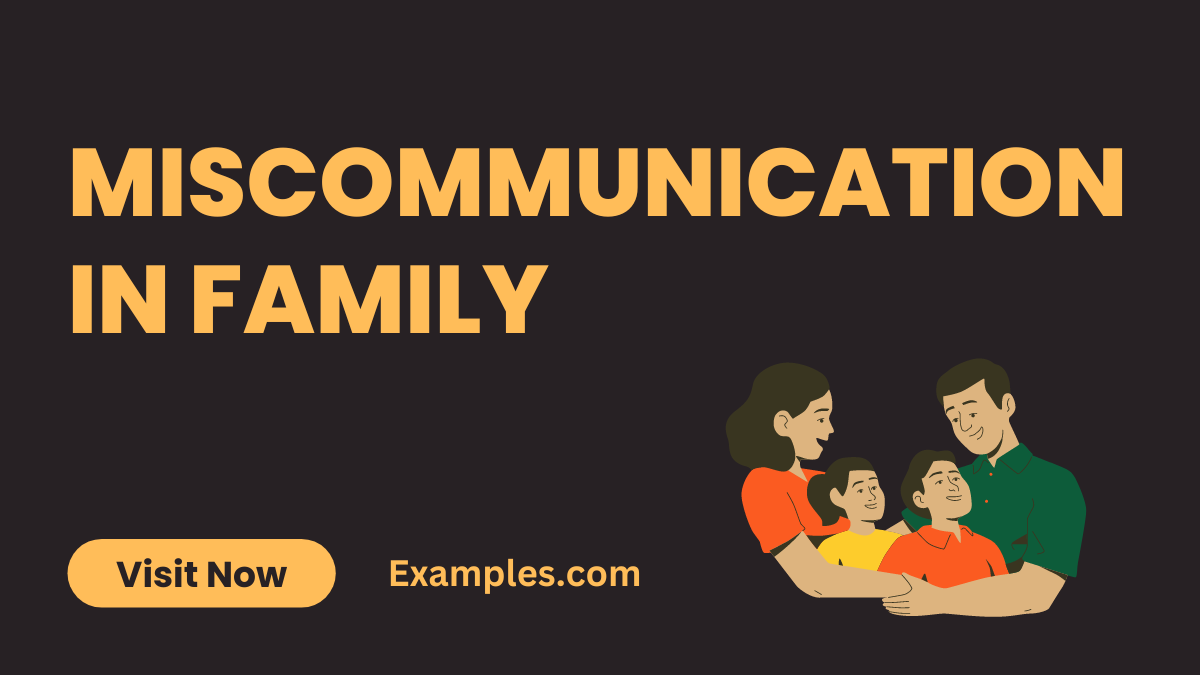19+ Miscommunication in Family Examples
Embark on a journey through the complexities of family dynamics in our comprehensive guide on “Miscommunication in Family.” Uncover the intricacies of communication examples within familial relationships, gaining valuable insights into common pitfalls. This guide navigates through real-life scenarios, offering actionable tips to enhance understanding and harmony. From generational gaps to conflicting perspectives, delve into the rich tapestry of miscommunication within families and equip yourself with strategies for fostering healthier and more effective communication.
What is Miscommunication in Family?
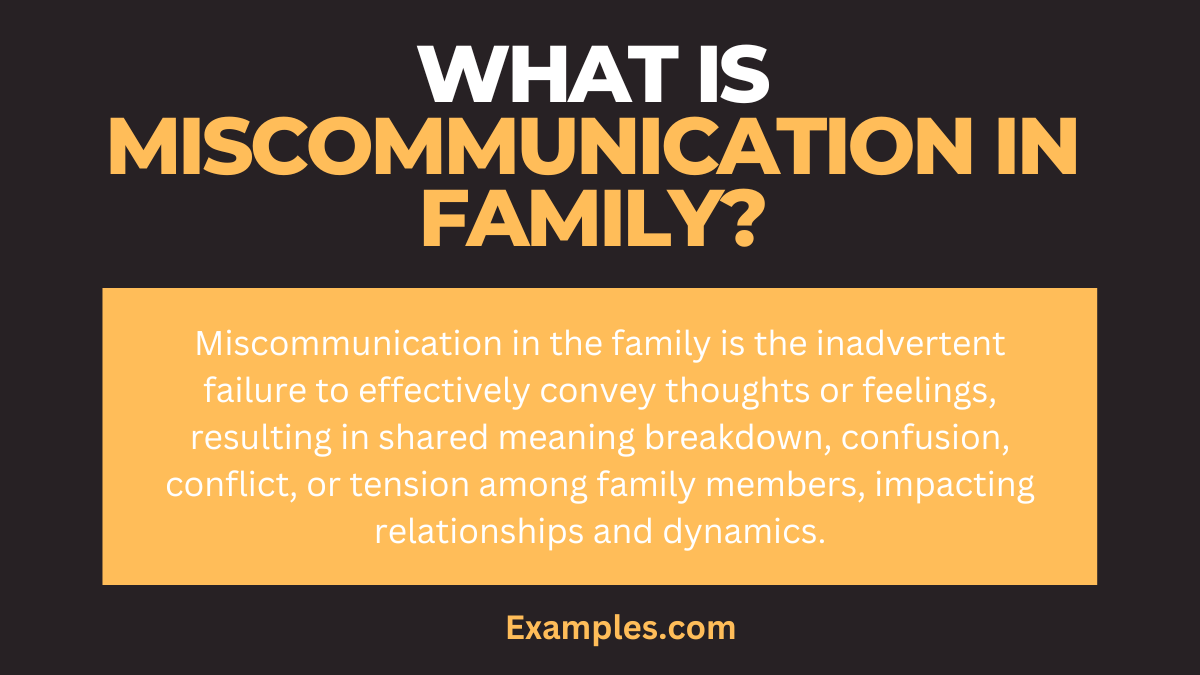
Miscommunication in the family occurs when there’s a failure to convey thoughts or feelings effectively, leading to misunderstandings. It involves a breakdown in shared meaning, often causing confusion, conflict, or tension. In simple terms, it’s the unintentional gaps in understanding among family members, impacting relationships and dynamics. This H2 heading aims to provide a clear and straightforward definition of miscommunication within the family context.
What is the Best Example of Miscommunication in Family?
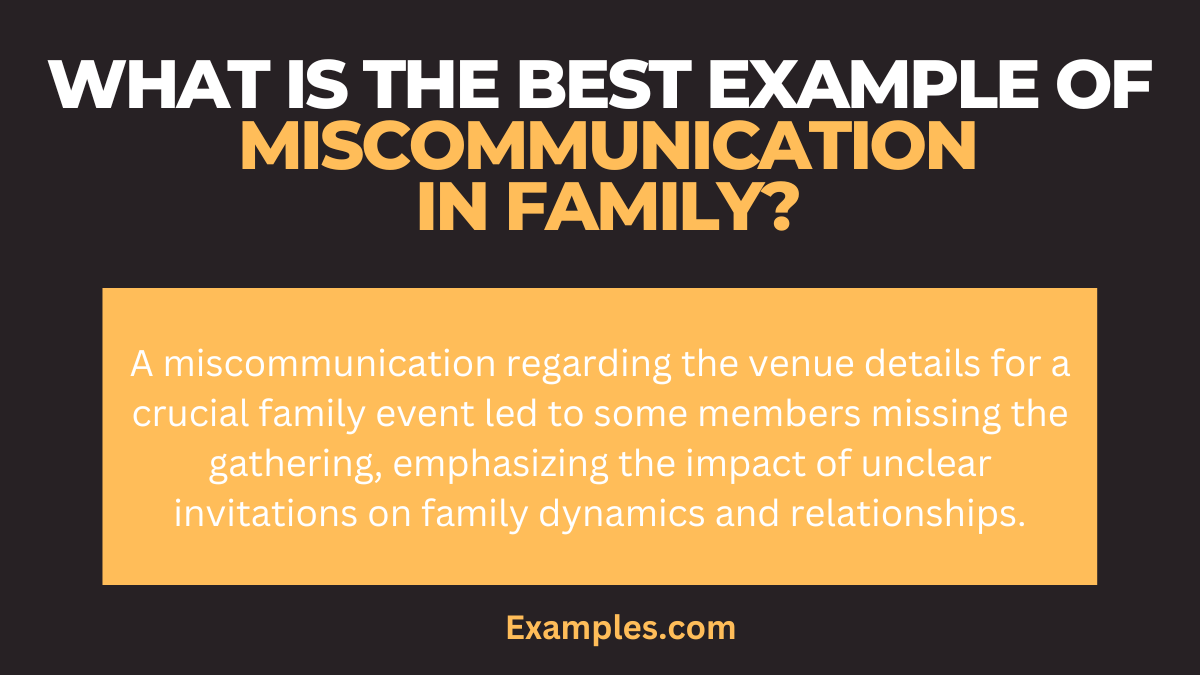
In this scenario, a crucial family event was planned, but due to a miscommunication about the venue, some members missed the gathering. The invitation had unclear details, leading to confusion. The resulting disappointment highlighted the impact of miscommunication on family dynamics. This detailed explanation explores the ramifications of the lost invitation, illustrating how simple misunderstandings can significantly affect family relationships and shared experiences.
20 Miscommunication in Family Examples
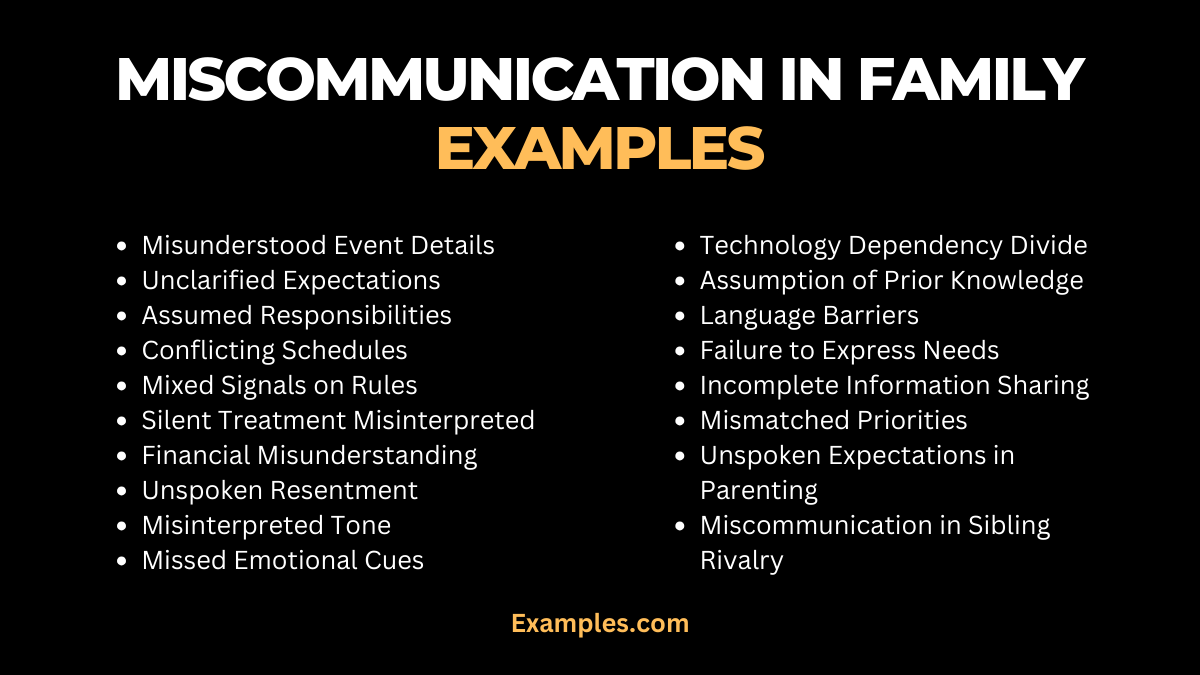
Explore these diverse miscommunication examples within families, shedding light on common pitfalls that affect relationships. This curated list, rich in real-life scenarios, serves as a valuable resource for understanding and navigating the complexities of family dynamics.
- Misunderstood Event Details: Confusion about event specifics leads to missed family gatherings, highlighting the importance of clear communication.
- Unclarified Expectations: Unmet expectations arise due to vague communication, emphasizing the need for explicit agreements.
- Assumed Responsibilities: Family members assume different roles due to unclear expectations, leading to frustration and resentment.
- Conflicting Schedules: Differing schedules cause miscommunication, resulting in missed opportunities for quality family time.
- Mixed Signals on Rules: Inconsistent communication about household rules creates confusion and discord among family members.
- Silent Treatment Misinterpreted: The silent treatment is misinterpreted as anger, highlighting the significance of open communication about emotions.
- Financial Misunderstanding: Financial decisions made without clear communication lead to misunderstandings and financial strain.
- Unspoken Resentment: Unaddressed issues create an atmosphere of unspoken resentment, emphasizing the need for open dialogue.
- Misinterpreted Tone: A misinterpreted tone in messages results in unnecessary conflicts, underlining the importance of clarity.
- Missed Emotional Cues: Failure to recognize emotional cues leads to misunderstandings, showcasing the need for empathy in communication.
- Technology Dependency Divide: Generational miscommunication arises due to technology gaps, stressing the importance of bridging divides.
- Assumption of Prior Knowledge: Assuming family members know certain details leads to miscommunication, emphasizing the value of explicit communication.
- Language Barriers: Language differences within multicultural families can result in misinterpretation, highlighting the need for cultural sensitivity.
- Failure to Express Needs: Unexpressed needs cause frustration, emphasizing the importance of vocalizing individual requirements.
- Incomplete Information Sharing: Withholding key details contributes to miscommunication, showcasing the impact of complete information sharing.
- Mismatched Priorities: Divergent family priorities lead to miscommunication, highlighting the need for aligning goals through dialogue.
- Unspoken Expectations in Parenting: Parenting expectations left unspoken cause conflicts, emphasizing the importance of discussing parenting styles.
- Miscommunication in Sibling Rivalry: Sibling conflicts arise from miscommunication, illustrating the need for clear channels of expression within the family.
- Disagreement Over Family Values: Differing interpretations of family values result in miscommunication, underlining the importance of aligning core beliefs.
- Emotional Withdrawal Misunderstood: Emotional withdrawal is misunderstood as apathy, emphasizing the necessity of open communication about emotional states.
This diverse compilation of miscommunication examples provides practical insights into navigating family relationships more effectively.
Miscommunication in Family for Students Examples
Navigate the challenges of familial miscommunication with scenarios tailored for students. This guide offers insights into unique miscommunication examples within a student’s family context, fostering understanding and effective communication for a harmonious home and academic life.
- Assignment Expectations Mismatch: A miscommunication about assignment details leads to confusion among family members, emphasizing the importance of clarifying academic expectations.
- Study Time Clash: Conflicting study times due to miscommunication result in disrupted learning environments, showcasing the need for synchronized schedules.
- Exam Stress Misunderstood: Misunderstanding about exam stress levels creates tension; clear communication helps family support during crucial academic periods.
- Career Goals Unshared: A student’s unshared career goals cause family misunderstandings, underlining the importance of transparent communication about future aspirations.
- Financial Support Assumptions: Assumptions about financial support lead to miscommunication; open dialogue ensures clear expectations for educational funding.
- College Decision Discrepancy: Discrepancies in college decisions due to miscommunication highlight the need for collaborative family discussions about educational choices.
- Online Learning Tech Gaps: Technology gaps in online learning cause miscommunication, emphasizing the necessity of addressing and resolving technical challenges together.
- Study Aid Misconceptions: Misconceptions about study aid preferences lead to ineffective support; transparent communication ensures tailored assistance for academic success.
- Internship Confusion: Confusion about internship commitments results in miscommunication; clear communication establishes expectations and avoids misunderstandings.
- Extracurricular Overlap: Miscommunication about extracurricular commitments leads to schedule clashes, demonstrating the importance of open dialogue for balancing academic and personal pursuits.
Miscommunication in Family at Home Examples
Explore real-life miscommunication instances within the home environment, uncovering ways to navigate and foster clearer communication. This guide focuses on family dynamics at home, providing insights into scenarios that students may encounter and offering effective communication strategies.
- Meal Preferences Misunderstanding: Conflicting meal preferences due to miscommunication create tension; open communication ensures meals that cater to everyone’s tastes.
- Chores Division Assumptions: Assumptions about chore divisions lead to miscommunication; clear communication ensures equitable responsibilities for a harmonious household.
- Privacy Expectations Clash: Clashes in privacy expectations due to miscommunication emphasize the importance of setting and communicating boundaries within the family home.
- Family Outing Miscoordination: Miscoordination in planning family outings results in misunderstandings; clear communication ensures everyone is on the same page for enjoyable experiences.
- Technology Usage Discrepancies: Discrepancies in technology usage cause family conflicts; open communication establishes guidelines for shared device use at home.
What are the effects of miscommunication in family?
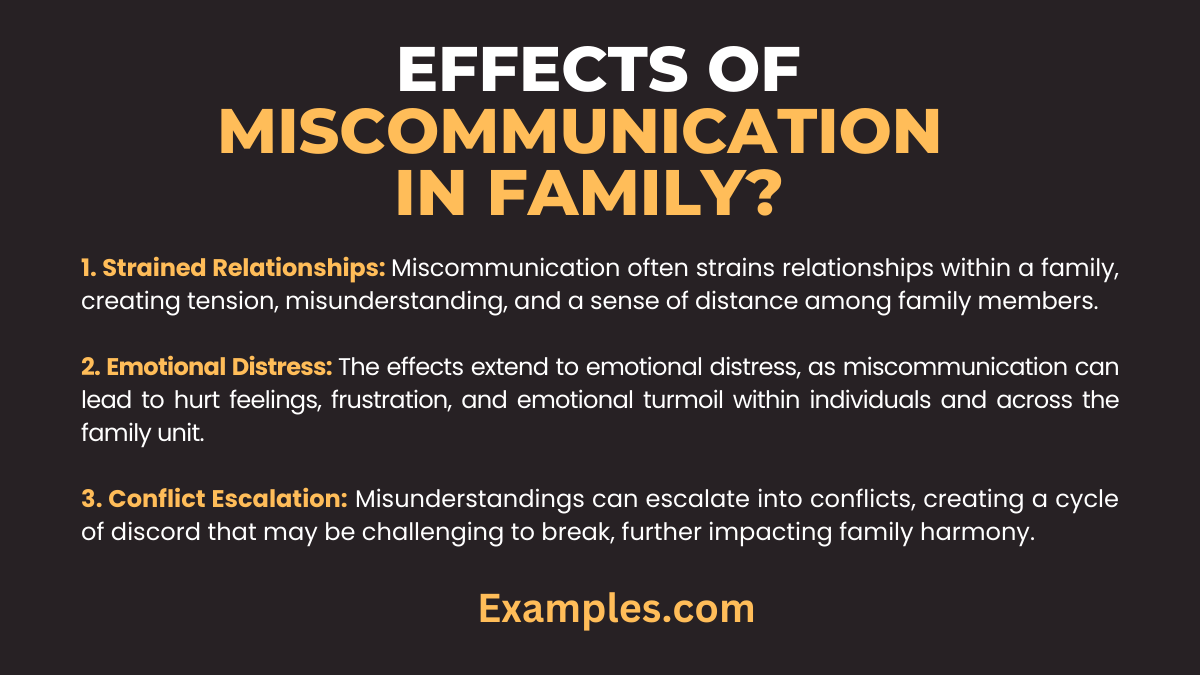
Miscommunication within a family can have profound and far-reaching impacts on relationships, dynamics, and overall well-being. This comprehensive guide delves into the effects of miscommunication in a family context, shedding light on the emotional, psychological, and relational consequences that may arise.
1. Strained Relationships: Miscommunication often strains relationships within a family, creating tension, misunderstanding, and a sense of distance among family members.
2. Emotional Distress: The effects extend to emotional distress, as miscommunication can lead to hurt feelings, frustration, and emotional turmoil within individuals and across the family unit.
3. Conflict Escalation: Misunderstandings can escalate into conflicts, creating a cycle of discord that may be challenging to break, further impacting family harmony.
4. Trust Erosion: Repeated miscommunication erodes trust among family members, as individuals may begin to question the reliability of information and intentions.
5. Reduced Collaboration: Effective collaboration often hinges on clear communication; miscommunication disrupts collaboration, hindering the family’s ability to work together on common goals.
6. Impact on Decision-Making: Miscommunication can significantly impact decision-making processes within the family, leading to choices that may not align with individual or collective preferences.
7. Increased Stress Levels: The strain caused by miscommunication contributes to heightened stress levels, affecting the mental and emotional well-being of family members.
8. Role Ambiguity: Ambiguity in communication may result in unclear role expectations, causing confusion about individual responsibilities and contributions within the family structure.
This guide provides an in-depth exploration of the multifaceted effects of miscommunication in a family setting, emphasizing the importance of fostering clear and open communication to maintain a harmonious and supportive family environment.
How do you deal with miscommunication in a family relationship?
Miscommunication is an inevitable aspect of family life, but navigating it effectively is crucial for maintaining healthy relationships. This guide explores practical strategies to address and overcome miscommunication within family dynamics, fostering understanding and harmony.
1. Cultivate Open Communication: Encourage family members to express thoughts and feelings openly. Create an environment where everyone feels heard and valued.
2. Active Listening Techniques: Develop active listening skills to truly understand each other. Validate emotions and ensure everyone feels acknowledged in conversations.
3. Clarify Expectations: Clearly communicate expectations to avoid assumptions. Discuss responsibilities, boundaries, and shared values to align family members’ understanding.
4. Choose the Right Time: Timing matters in communication. Choose appropriate moments for discussions, ensuring everyone is in a receptive state.
5. Utilize Non-Verbal Cues: Pay attention to non-verbal cues like body language and facial expressions. Often, these convey more than words and provide insight into emotions.
6. Encourage Empathy: Foster empathy within the family. Encourage members to consider each other’s perspectives, fostering compassion and mutual understanding.
7. Use “I” Statements: Frame concerns using “I” statements to express personal feelings without assigning blame. This promotes a non-confrontational approach to communication.
8. Seek Clarification: When in doubt, seek clarification. Encourage family members to ask questions to ensure everyone is on the same page.
Tips for Effective Miscommunication in Family?
Effective communication is the cornerstone of harmonious family dynamics. Navigate potential pitfalls and foster clear understanding with these tips tailored to mitigate miscommunication within your family.
- Clarity in Expression: Communicate with clarity and precision. Clearly articulate thoughts and feelings to avoid misunderstandings caused by vague or ambiguous language.
- Encourage Open Dialogue: Foster an environment where family members feel comfortable expressing their thoughts and concerns. Encourage open dialogue to address issues before they escalate.
- Regular Family Meetings: Schedule regular family meetings to discuss important matters and provide a platform for everyone to share their viewpoints, ensuring collective decisions are well-informed.
- Clarify Expectations: Clearly communicate expectations regarding responsibilities, commitments, and plans to prevent misunderstandings arising from assumptions or differing interpretations.
- Choose the Right Timing: Pick suitable times for discussions, avoiding high-stress situations. Timing significantly influences receptiveness, ensuring family members are more open to effective communication.
- Utilize Technology Mindfully: While technology facilitates communication, use it mindfully. Miscommunication often arises from text misinterpretations; opt for face-to-face or video conversations for important discussions.
In conclusion, this comprehensive guide illuminates the intricacies of miscommunication in family dynamics. With real-life examples and practical insights, it serves as a valuable resource for understanding, navigating, and ultimately improving communication within the family unit. By learning from these examples, families can foster understanding, strengthen relationships, and create a more harmonious and connected living environment.



